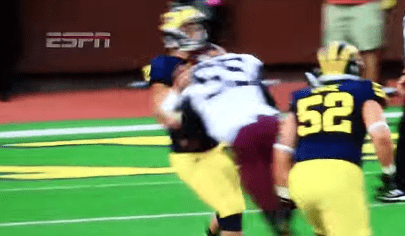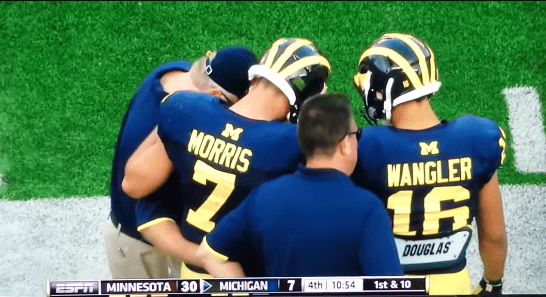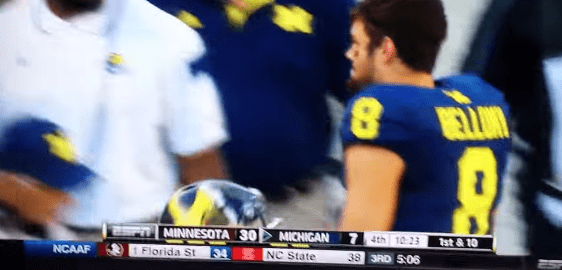Although I'm a proud alum of Northwestern University, a former marching band member, and an ardent follower of our football team (as I've written about before), I grew up as a fan of the Michigan Wolverines and have many friends who are alumni.
After watching NU shock Penn State on Saturday, I flipped over to the Michigan game, where they were being upset by Minnesota, losing 30-7 in Ann Arbor (which led to a lot of boos and empty seats).
This post is not a “football story,” it's a “safety story” — about sports and hospitals.
Shane Morris Gets Concussed
In his first game as the starter, Michigan quarterback Shane Morris was already hobbling around on an injured leg. Considering the score, a “safety first” approach might have included taking him out of the game, since he was clearly injured. But, he was “being a competitor,” I'm sure and might have been afraid of losing his starting spot.
In the fourth quarter, Morris took a vicious hit to the chin and head (on a play that should have drawn a penalty and ejection against the Minnesota player):

Morris got up, and was visibly woozy and stumbled around. He needed a teammates help to stay vertical, it seemed. Of course, his leg was already injured, which could have caused the wobbly-ness.
Update: Michigan says that Morris did suffer a “mild concussion.”
But, you can see how dazed he looks in this photo from the Detroit Free Press.
Shockingly, Morris stayed in the game for the next play. Neither the coaches nor the training staff sent in Devin Gardner, the former starting quarterback and now backup. They didn't call time out. They didn't ask for an injury time out to check on him. They left him in the game. Were they still trying to win the game? Did they think Morris was still their best shot? Were they not paying attention?
After that next play, Michigan finally DID send Gardner into the game.
Gardner promptly had his helmet knocked off (not through a vicious hit) and, by rule, had to come out of the game for one play (a rule that's there for safety, to encourage the proper buckling of helmet straps).
The coaches and staff didn't take Morris' helmet away from him, as is normally done when a concussion is suspected. They were still talking to him in what looks like the context of coaching and not medical evaluation (and holding him up?):

Immediately after Gardner's helmet came off, we see the third string quarterback, #8 Russell Bellomy, on the sideline. He's wearing a baseball cap and headset and starts scrambling to look for his helmet. He can't find it. He's handed a few helmets and tries them on, saying no to each… so he can't go into the game.

Morris, who was sitting on the bench, with his helmet off… is sent back into the game by the Michigan coaches for one play before Gardner can come back in.
The referee, to his credit asks the sideline if they want a time out (you can see this clearly at 5:41 in the video).
Video of this can be found below (at least for the moment)… there are other videos posted here.
The ESPN announcers were pretty harshly critical of the Michigan coaches and staff for allowing Morris to go back in. I agree with their criticism. They were criticizing Michigan for keeping in the game before the head injury, just due to his leg injury, which was limiting his mobility.
It's not known if Morris actually had a concussion, but he was “carted off” at the end of the game.
This piece also summarizes the issues and nails the analysis, I think. This commentary spells out the guidelines on suspected concussions and the things that Michigan could have done instead of putting Morris back in there.
We could ask all sorts of questions, looking for process and system problems:
- Why didn't Michigan follow better protocols when a player clearly had a head injury?
- Why didn't game officials stop the game, seeing the injury, for an “injury timeout,” even though Morris got back up?
- Why didn't Michigan make sure Bellomy was ready once Gardner went into the game, realizing Bellomy was one hit away from having to go in?
- What is their “helmet management system” if a player isn't wearing or holding it?
Michigan Releases an Empty Statement
Head coach Brady Hoke is under fire, not just for losing games, but for not looking out for the safety of Morris. I'll assume Michigan fans are more upset about player safety than they are about losing two straight home games.
From this article:
“After the game, Hoke said he didn't know whether Morris had suffered a concussion and said if Morris wanted out of the game, he would have said so.”
Best practices and common sense say that a player, after a major shot to the head, isn't allowed to make the decision about staying in the game. They might not be thinking clearly. That's why the coaches and trainers have an obligation to make that decision for the player.
Michigan released a statement:
“The safety of our student-athletes is always our top priority. We generally never discuss the specifics of a student-athlete's medical care, but Shane Morris was removed from yesterday's game against Minnesota after further aggravating an injury to his leg that he sustained earlier in the contest. He was evaluated by our experienced athletic trainers and team physicians, and we're confident proper medical decisions were made. The University of Michigan has a distinguished group of Certified Athletic Trainers and team physicians who are responsible for determining whether or not a player is physically able to play. Our coaches have no influence or authority to make determinations if or when an injured player returns to competition. The health and welfare of our student-athletes is and will continue to be a top priority.”
For some reason, they only mention the leg injury, not the head injury. They're avoiding the main situation there.
They repeat twice that safety is the “top priority.” The problem is that their actions very clearly suggest otherwise.
The actions and the videos don't back up the words. They ring hollow.
Hospitals Make Similar Empty Statements
Of course, many hospitals also have statements on their websites about patient safety being a “top priority” or an “utmost priority.” I'm not sure daily actions back up those statements either.
Every time there's an incident with preventable patient harm (see the stats), it seems the hospital or health system puts out a reassuring statement that says “patient safety is our top priority,” as if that reassures people.
The proof is in the pudding. We have to walk the talk. Insert more clichés here.
If a hospital is understaffed, has bad processes, and a culture that discourages people from speaking up and pointing out risks and problems, you can't say you're making patient safety the top priority or the utmost concern. It's just a bunch of “happy talk,” as Pascal Dennis calls it.
If hospital leaders spent more time talking about finances and patient counts than they spend talking about safety, then it's not a “top priority.”
I heard a hospital CEO give a speech last week where he showed data that was pretty definitive that the hospital is in the 50th to 75th percentiles in most major categories of preventable patient harm.
Yet, he ended his speech with flowery happy talk about how “he doesn't want any patient to walk in feeling like it's not the safest hospital in America.” Well, the data say it is not. But, the CEO is good at happy talk. He conveniently chose not to take questions after his talk.
The problem with the patient safety crisis is that we don't have video or ESPN commentators criticizing the hospital and its practices. So, the problem remains unseen and unfixed.
Please scroll down (or click) to post a comment. Connect with me on LinkedIn.
Let’s build a culture of continuous improvement and psychological safety—together. If you're a leader aiming for lasting change (not just more projects), I help organizations:
- Engage people at all levels in sustainable improvement
- Shift from fear of mistakes to learning from them
- Apply Lean thinking in practical, people-centered ways
Interested in coaching or a keynote talk? Let’s talk.
Join me for a Lean Healthcare Accelerator Trip to Japan! Learn More










“If hospital leaders spent more time talking about finances and patient counts than they spend talking about safety, then it’s not a “top priority.”
This reminds me of the Tom Peters line, “You are your calendar.”
The gist: if you tell me that quality if your number one priority, and I look at your calendar and don’t see that you’ve spent most of your time on quality, then it may be important, but it’s not your priority. The calendar never lies.
Great point.
How many seniors leaders have “zero” time on their calendar for patient safety because they’ve mistakenly thought they could delegate that responsibility?
What a great suggestion to have someone analyze your calendar. It’s helpful to have that ‘truth teller’ who will provide you honest feedback and constructive criticism. One of the best bosses I had used to do a safety check of her unit at the beginning of her day and at the end. Eventually her staff all followed suit and you would often see staff modeling her behavior.
Head Coach Brady Hoke is shirking responsibility… maybe passing it off on the doctors. Many coaches say, “if the doctors clear the player, they can do back in.”
LINK
He said he doesn’t “make decisions on who plays, who doesn’t play.”
When asked if Morris had been checked out by doctors, he said “I assume so.”
Wrong answer.
Update: See this news story and a release from the athletic director:
They say Morris had a “mild concussion” and that “communications breakdowns” occurred on the sideline.
“This is another mistake that cannot occur again.”
Statement by U-M President Mark S. Schlissel:
In part:
Though the U of M president presents a better public face than the coach, words like “accountability”, “vigilant”, and “enforce” don’t impress. Echoes of safety programs at work built around posting signs telling people to “Be more careful”. What is absent is public acknowledgement of the need to ask “why did this happen?”, to keep asking why, and take action to prevent recurrence.
In the case of head injuries, football, and NCAA Division I schools, I’m afraid that an honest “5 whys” will not be explored, as they might cause us to question the place of football in educational institutions.
I agree the words might be empty. To their credit, they did make some systemic changes to how their sideline medical staff work and communicate. That said, I cringed when the AD threw the athletic trainers and medical staff “under the bus” and said it wasn’t Coach Hoke’s fault.
I bet some people on that staff are pretty upset.